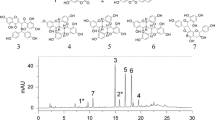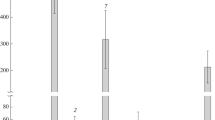Abstract
Aqueous extracts of fresh leaves and organic soil of northern sheep laurel (Kalmia angustifolia var.angustifolia) were found to be inhibitory to the growth of black spruce (Picea mariana) germinants. Primary root growth of black spruce was more affected by the extracts than was shoot growth. The growth inhibition caused by the leaf extract was most pronounced under acidic conditions (pH 3–4). The aqueous extract ofKalmia leaves contained ferulic, vanillic, syringic, gentisic,m-coumaric,p-coumaric,o-hydroxyphenylacetic, andp-hydroxybenzoic acids as well as some other unknown compounds. These compounds were isolated from the aqueous extract ofKalmia leaves by ethyl acetate extraction and identified using thin-layer chromatography (TLC) and high-performance liquid chromatography (HPLC). Bioassay indicated that the overall toxicity of the phenolic compounds to black spruce appeared to increase in the order ofo-hydroxyphenylacetic,p-hydroxybenzoic, vanillic,p-coumaric, gentisic, syringic, ferulic, andm-coumaric acids.
Similar content being viewed by others
References
Ballester, A., Albo, J.M., andVieitez, E. 1977. The allelopathic potential ofErica scoparia L.Oecologia 30:55–61.
Candy, R.H. 1951. Reproduction on cut-over and burned-over land in Canada. Canadian Department of Research and Development, Forest Research Division, Silviculture Research Note No. 92, 224 pp.
Carballeira, A. 1980. Phenolic inhibitors inErica australis L. associated soil.J. Chem. Ecol. 6:593–596.
Chou, C.H., andMuller, C.H. 1972. Allelopathic mechanisms ofArctostaphylos glandulosa var.Zacaensis. Am. Midl. Nat. 88:324–347.
Damman, A.W.H. 1971. Effect of vegetation changes on the fertility of a Newfoundland forest site.Ecol. Monogr. 41:253–270.
Damman, A.W.H. 1975. Permanent changes in the chronosequence of a boreal forest habitat induced by natural disturbance, pp. 499–515,in W. Schmidt (ed.). Susessionforschung. Cramer, Vaduz, Germany.
Del Moral, R., andCates, R.G. 1971. Allelopathic potential of the dominant vegetation of western Washington.Ecology 52:1030–1037.
Del Moral, R., andMuller, C.H. 1970. Allelopathic effects ofEucalyptus camaldulensis.Am. Midl. Nat. 83:254–280.
Fisher, R.F. 1980. Allelopathy: A potential cause of regeneration failure.J. For. 78:346–348.
Gimingham, C.H. 1972. Ecology of Heathlands. Chapman and Hall, London.
Grubb, P.J., Green, H.E., andMerrifield, R.C.J. 1969. The ecology of chalk heath: Its relevance to the calcicole-calcifuge and soil acidification problems.J. Ecol. 57:175–212.
Handley, W.R.C. 1963. Mycorrhizal association andCalluna heathland afforestation. Forestry Commission Bulletin 36, H.M.S.O., London.
Hobbs, R.J. 1984. Possible chemical interactions among heathland plants.Oikos 43:23–29.
Hartley, R.D., andWhithead, D.C. 1985. Phenolic acids in soils and their influence on plant growth and soil microbial processes, pp. 109–149,in D. Vaughan and R.E. Malcolm (eds.). Soil Organic Matter and Biological Activity. Martinuh Nijhoff and Dr. W. Junk, Boston.
Jalal, M.A.F., andRead, D.J. 1983a. The organic acid composition ofCalluna heathland soil with special reference to phyto- and fungitoxicity. I. Isolation and identification of organic acids.Plant Soil 70:257–272.
Jalal, M.A.F., andRead, D.J. 1983b. The organic acid composition ofCalluna heathland soil with special reference to phyto- and fungitoxicity. II. Monthly quantitative determination of the organic acid content ofCalluna and spruce dominated soils.Plant Soil 70:273–286.
Jalal, M.A.F., Read, D.J., andHaslam, E. 1982. Phenolic composition and its seasonal variation inCalluna vulgaris.Phytochemistry 21:1397–1401.
Lee, R.B. 1977. Effects of organic acids on the loss of ions from barley roots.J. Exp. Bot. 28:578–587.
Lynch, J.M. 1980. Effects of organic acids on the germination of seeds and growth of seedlings.Plant Cell Environ. 3:255–259.
Mallik, A.U. 1987. Allelopathic potential ofKalmia angustifolia to black spruce (Picea mariana).For. Ecol. Manage. 20:43–51.
Mallik, A.U. 1990. Allelopathy and the competitive advantage ofKalmia angustifolia over black spruce,in B.D. Titus et al. (eds.). Silvic and Ecology of Boreal Spruces. IUFRO Working Party, 51.05–12 Symposium Proceedings, Newfoundland, August 12–17, 1989. Forestry Canada Information Report N-X 271.
Mallik, A.U. 1991. Cutting, burning and mulching to controlKalmia: A greenhouse experiment.Can. J. For. Res. 21:417–420.
Mallik, A.U. 1993. Ecology of a forest weed of Newfoundland: Vegetative regeneration strategy ofKalmia angustifolia.Can. J. Bot. 71:161–166.
Mallik, A.U., andNewton, P.F. 1988. Inhibition of black spruce seedling growth by forest-floor substrates of central Newfoundland.For. Ecol. Manage. 23:273–283.
Meades, W.J. 1986. Successional status of ericaceous dwarf-shrub heath in eastern Newfoundland. Ph.D. thesis. University of Connecticut, Storrs.
Oden, P.C., Brandtberg, P.O., Anderson, R., Gref, R., Zackrisson, O., andNilsson, M.C. 1992. Isolation and characterization of a germination inhibitor from leaves ofEmpetrum hermaphorditum (Hagerup).Scand. J. For. Res. 7:497–502.
Peterson, E.B. 1965. Inhibition of black spruce primary roots by water-soluble substance inKalmia angustifolia.For. Sci. 11:475–479.
Pritchett, W.L. 1979. Properties and Management of Forest Soils. John Wiley & Sons, New York.
Read, D.J. 1984. Interactions between ericaceous plants and their competitors with special reference to soil toxicity, pp. 195–209,in Weed Control and Vegetation Management in Forests and Amenity Areas, Aspects of Applied Biology No. 5.
Rice, E.L. 1984. Allelopathy. Academic Press, New York.
Richardson, J. 1975. Establishment of a study to compare different means of reforesting sites invaded byKalmia. Newfoundland Forest Research Centre File Report Study 8-8.
Robinson, R.K. 1971. Importance of soil toxicity in relation to the stability of plant communities, pp. 105–113,in E. Duffey and A.S. Watts (eds.). The Scientific Management of Animal and Plant Communities for Conservation. British Ecological Society Symposium 11. Blackwell, Oxford.
Robinson, R.K. 1972. The production by roots ofCalluna vulgaris of a factor inhibitory to growth of some mycorrhizal fungi.J. Ecol. 60:219–224.
Rowe, J.W., andScotter, G.W. 1973. Fire in the boreal forest.Quat. Res. 3:444–464.
Thompson, I.D., andMallik, A.U. 1989. Moose browsing and allelopathic effects ofKalmia angustifolia on balsam fir regeneration in central Newfoundland.Can. J. For. Res. 9:524–526.
Wall, R.E. 1977. Ericaceous ground cover on cutover sites in southwestern Nova Scotia. Canada Department of Fisheries and Environment, Canadian Forestry Service, Information Report N-X-71.
Author information
Authors and Affiliations
Rights and permissions
About this article
Cite this article
Zhu, H., Mallik, A.U. Interactions betweenKalmia and black spruce: Isolation and identification of allelopathic compounds. J Chem Ecol 20, 407–421 (1994). https://doi.org/10.1007/BF02064447
Received:
Accepted:
Issue Date:
DOI: https://doi.org/10.1007/BF02064447




